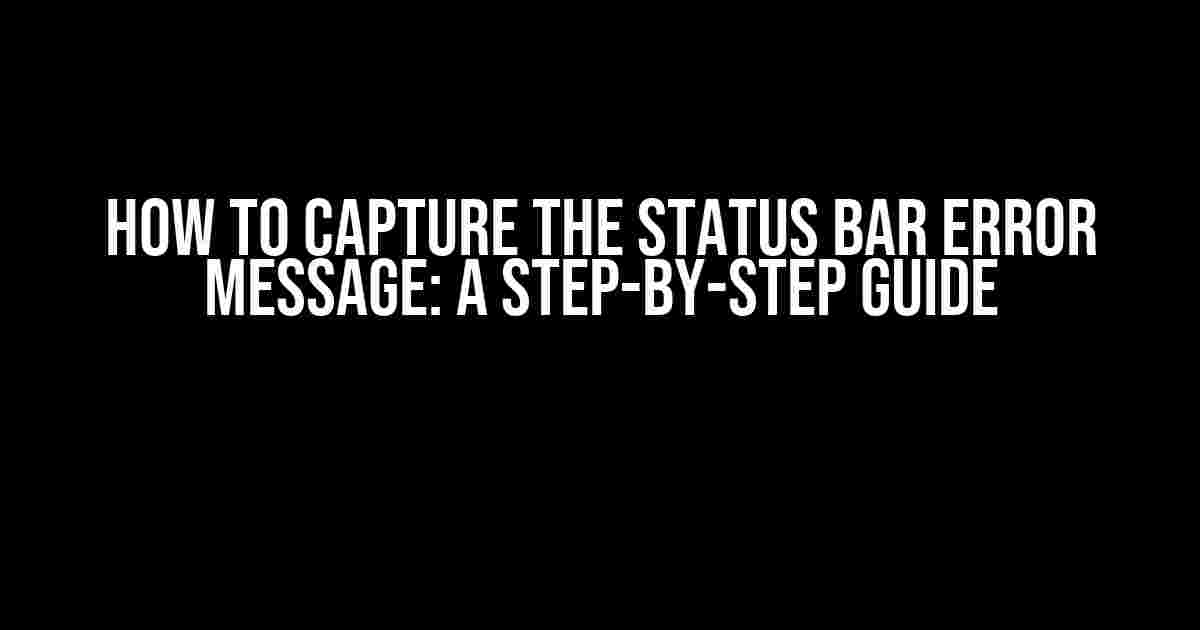Are you tired of dealing with pesky error messages on your website or application? Do you want to know the secret to capturing those elusive status bar error messages? Look no further! In this article, we’ll show you how to capture the status bar error message with ease.
Understanding the Status Bar Error Message
Before we dive into the meat of the matter, let’s take a step back and understand what the status bar error message is. The status bar error message is an error message that appears on the status bar of your browser or application when something goes wrong. It’s usually a cryptic message that doesn’t provide much context, leaving you scratching your head.
Why Capture the Status Bar Error Message?
Capturing the status bar error message is crucial for several reasons:
- Debugging purposes**: Capturing the error message helps you identify the source of the problem, making it easier to debug and fix the issue.
- Improved user experience**: By capturing the error message, you can provide a better user experience by displaying a user-friendly error message instead of leaving the user confused.
- Error tracking and analytics**: Capturing the error message allows you to track and analyze errors, helping you identify patterns and trends.
Capturing the Status Bar Error Message: Methods and Techniques
Now that we’ve covered the why, let’s move on to the how. There are several methods and techniques to capture the status bar error message, and we’ll cover them in detail.
Method 1: Using the Console Log
The console log is a powerful tool that allows you to capture error messages and debug your code. Here’s how to use the console log to capture the status bar error message:
console.error("Error message: ", error.message);
This code snippet will log the error message to the console, making it easy to capture and analyze.
Method 2: Using Try-Catch Blocks
Try-catch blocks are another effective way to capture the status bar error message. Here’s an example:
try {
// your code here
} catch (error) {
console.error("Error message: ", error.message);
}
This code snippet will catch any errors that occur within the try block and log the error message to the console.
Method 3: Using Error Handlers
Error handlers are a type of event listener that can be used to capture error messages. Here’s an example:
window.addEventListener("error", function(event) {
console.error("Error message: ", event.message);
});
This code snippet will capture any error messages that occur on the window object and log them to the console.
Capturing the Status Bar Error Message in Different Browsers
Different browsers have different ways of capturing the status bar error message. Here’s a breakdown of how to do it in popular browsers:
| Browser | Method |
|---|---|
| Google Chrome | Use the console log or try-catch blocks |
| Mozilla Firefox | Use the error console or try-catch blocks |
| Microsoft Edge | Use the console log or try-catch blocks |
| Safari | Use the console log or error handlers |
Best Practices for Capturing the Status Bar Error Message
Now that we’ve covered the how, let’s talk about best practices for capturing the status bar error message:
- Log error messages consistently**: Use a consistent format for logging error messages to make it easier to analyze and track errors.
- Use meaningful error messages**: Use meaningful and descriptive error messages that provide context and help you identify the source of the problem.
- Handle errors gracefully**: Handle errors gracefully by providing a user-friendly error message and avoiding intrusive error messages that disrupt the user experience.
Conclusion
Capturing the status bar error message is a crucial step in providing a better user experience and debugging your code. By using the methods and techniques outlined in this article, you can easily capture and analyze error messages, improving your overall development workflow.
Remember, capturing the status bar error message is not a one-size-fits-all solution. Experiment with different methods and techniques to find what works best for your specific use case.
Final Thoughts
Capturing the status bar error message is an essential skill for any developer or designer. By following the instructions and best practices outlined in this article, you’ll be well on your way to capturing those elusive error messages and providing a better user experience.
So, what are you waiting for? Start capturing those error messages today and take your development skills to the next level!
Here are 5 Questions and Answers about “How to capture the status bar error message” in HTML format:
Frequently Asked Question
Having trouble capturing those pesky status bar error messages? Worry not, we’ve got you covered! Here are some FAQs to help you out:
Q1: How do I capture the status bar error message in Android?
You can use the `getStatusBarNotification()` method in the `NotificationListenerService` class to capture the status bar error message in Android. This method returns a `StatusBarNotification` object, which contains the error message.
Q2: Can I capture error messages from all types of notifications?
Unfortunately, no. The `getStatusBarNotification()` method only captures error messages from system notifications, not from custom notifications sent by apps. You’ll need to use a different approach for custom notifications.
Q3: How do I capture error messages in iOS?
In iOS, you can use the `UNNotification` class to capture error messages. Specifically, you can use the `requestAuthorizationWithOptions` method to request permission to access notifications, and then use the `didReceive` method to capture error messages.
Q4: Can I capture error messages programmatically?
Yes, you can! In both Android and iOS, you can use programming languages like Java, Kotlin, or Swift to write code that captures error messages. You can use APIs and frameworks like Android’s `NotificationListenerService` or iOS’s `UNNotification` to programmatically capture error messages.
Q5: Are there any third-party libraries or tools that can help me capture error messages?
Yes, there are! There are several third-party libraries and tools available that can help you capture error messages, such as Crashlytics, Fabric, or Bugsnag. These tools provide APIs and SDKs that make it easy to capture and report error messages.
I hope this helps! Let me know if you need anything else.


